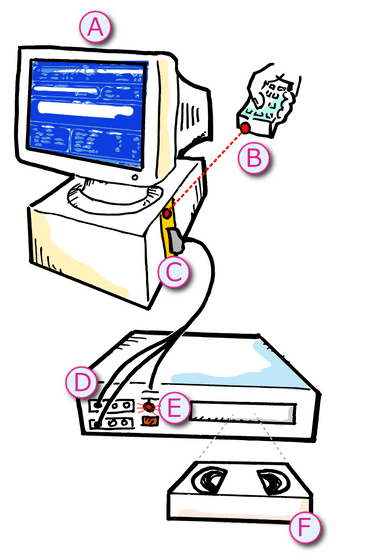What is 'ArVid', a Russian technology that packs the data of 4 HDDs into a VHS tape?

In the 1990s, in Russia after the collapse of the Soviet Union, a method was invented to record data on 'VHS' instead of HDDs, which were expensive at the time. Blogger Jacob Philip explains about Russia's innovative product `` ArVid ,'' which was able to squeeze the data of four HDDs into one VHS.
ArVid: how Russians squeezed 4 hard drives into one VHS tape in the 90s – Jacob Filipp
At the time, HDDs had a capacity of only about 500MB at most, and a large amount of HDD was required to store large amounts of data. However, in Russia at the time, one HDD was so expensive that it was equivalent to one month's salary, and it was difficult to secure large-capacity recording media.
In order to improve this situation, 'ArVid' is a device developed in Russia. By connecting a computer and a home video deck via an ISA bus expansion card , this product allows you to save data from four HDDs onto a VHS tape. The price was less than half that of HDDs at the time, so when combined with VHS, which was a quarter of the price of HDDs, it was a truly unprecedented recording medium.
The contents of ArVid include the main ArVid card, several 3.5-inch floppy disks, and instructions. Each floppy disk contained drivers and documentation.

The main card looks like this. This card is compatible with PC-386 motherboards. The plate has a port for the cable and a diode for receiving infrared signals.

Another item included was a custom cable that connects the computer to the VCR. In addition to the standard 'video input' and 'video output' connectors, there was also a wire (circled in red) with an infrared emitting LED at the tip.

The operation of ArVid is illustrated below. The program's interface is displayed on the PC with ArVid inserted (A), and the user uses the VCR's remote control to send commands such as 'play' to the ArVid card (B). Then, a signal is sent to the video deck (D) via a cable (C) that transmits video signal input/output and infrared signals, and further processing is performed to impersonate a remote control and emit a pre-recorded signal (E ). It seems that the data is recorded on VHS(F) through this process.

Through this process, we were able to store 2GB of data on a VHS tape that can record for 3 hours.
The crux of ArVid is that it 'masquerades as a remote control.' To accomplish this trick, the user had to 'teach' ArVid which infrared remote control signals correspond to commands such as 'play,' 'stop,' and 'rewind.' In order to teach the students, they had to hold the VCR's remote control over the receiving diode on the back of the computer and press the buttons on the remote control indicated by the software in order. In some cases, it took up to three hours to teach all the commands on the remote control.

Early models had a recording speed of 100 KB per second, and later models could record 2.16 GB of data on the same tape at 200 KB per second. Considering that the capacity of a 3.5-inch floppy disk was 1.44MB and the popularity of VHS tapes in the 1990s, it can be said that large-capacity data storage was realized at an extremely low price.
However, due to the nature of the medium called VHS tape, it would wear out, so it was not possible to rewrite it many times. Vendor PO KSI positions ArVid as a competitor to 'backup providers' such as Colorado Memory Systems and QIC systems, with 'write once, read often' as the ideal use case. . Additionally, the primary target was primarily businesses rather than individuals. At that time, the World Wide Web was in its infancy, and few individuals had enough data to fill several 2GB tapes.

Additionally, a variety of factors could cause problems reading tapes, such as different versions of ArVid hardware, write density, VCR quality, and even differences in processing power between the two computers, making ArVid It is reported that not many people used it for 'exchanging data between individuals.' However, it is said that there was also the act of purchasing VHS packed with large amounts of game software on the black market and reselling them.
ArVid enjoyed some popularity in the 1990s, but its popularity declined as HDDs and CD-Rs became cheaper, and its production was discontinued in 1998. The vendor PO KSI still exists as of 2024 and claims that ``200,000 ArVid were manufactured,'' but there seems to be a hot debate as to the authenticity of this claim.
Related Posts:
in Hardware, Posted by log1p_kr







